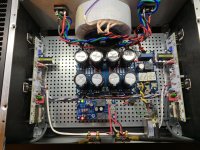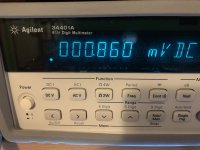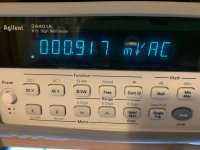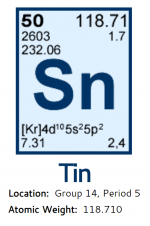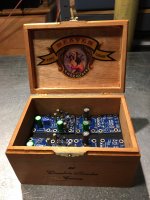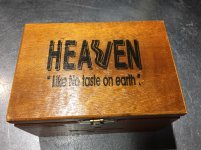Just completed my build tonight, I have teabags boards in right now and building up the m2x for a comparison. Shielding wasn’t needed with the layout.
I used a 4.3k in series with R7 to mitigate the negative offset
This build puts out 22.5wpc at 1%THD
I used a 4.3k in series with R7 to mitigate the negative offset
This build puts out 22.5wpc at 1%THD
Attachments
Last edited:
I haven't re-read every post, so apologies if this has already been covered but if anyone is daunted by the Norwood smd board the answer may be - glue. I was all set to have a crack at it when Tom Christiansen's HP-1 board arrived and thoughts immediately turned to an easier way to build it. Toothpicks seemed rather primitive (if cheap) and you still seem to need three hands and a clamp, and I thought that maybe a commercial oven would require some kind of adhesive to immobilise all the components on a board. Youtube revealed a diy method using fisherman's fly-tieing UV sensitive glue (and a toothpick!) plus torch, and this will now be my approach. The Norwood should be a breeze.
Good on ya! If it helps you succeed at hand-soldering SMD, that's fantastic.
Norwood uses huge (compared to other SMD parts) components: 1206 resistors and capacitors, SOIC-8 integrated circuits. SOT23-3 discretes. So, compared to other SMD boards, Norwood should be one of the easier jobs of assembly and soldering. Wait till you have to solder 0402 size resistors and MELF (cylindrical! they roll off your board!) diodes. Oof.
As mentioned previously, these are the items which I personally used to build 30 Norwood boards in February, and which were the keys to hand-soldering SMD success, for me. I find that teeny tiny (0.38mm) Multicore brand solder is extremely helpful.
Norwood uses huge (compared to other SMD parts) components: 1206 resistors and capacitors, SOIC-8 integrated circuits. SOT23-3 discretes. So, compared to other SMD boards, Norwood should be one of the easier jobs of assembly and soldering. Wait till you have to solder 0402 size resistors and MELF (cylindrical! they roll off your board!) diodes. Oof.
As mentioned previously, these are the items which I personally used to build 30 Norwood boards in February, and which were the keys to hand-soldering SMD success, for me. I find that teeny tiny (0.38mm) Multicore brand solder is extremely helpful.
Amazon.com: YOCTOSUN Head Mount Magnifier with 2 Led Professional Jeweler's Loupe Light Bracket and Headband are Interchangeable: Toys & Games
Amazon.com: Circuit Board Working Platform: Electronics
Hakko T18BL Series Soldering Tip for FX-888/FX-8801, Conical, R 0.2 mm x 22.5 mm: Soldering Iron Tips: Amazon.com: Industrial & Scientific
386844 Multicore | Soldering, Desoldering, Rework Products | DigiKey
Amazon.com: Circuit Board Working Platform: Electronics
Hakko T18BL Series Soldering Tip for FX-888/FX-8801, Conical, R 0.2 mm x 22.5 mm: Soldering Iron Tips: Amazon.com: Industrial & Scientific
386844 Multicore | Soldering, Desoldering, Rework Products | DigiKey
Good on ya! If it helps you succeed at hand-soldering SMD, that's fantastic.
Norwood uses huge (compared to other SMD parts) components: 1206 resistors and capacitors, SOIC-8 integrated circuits. SOT23-3 discretes. So, compared to other SMD boards, Norwood should be one of the easier jobs of assembly and soldering. Wait till you have to solder 0402 size resistors and MELF (cylindrical! they roll off your board!) diodes. Oof.
As mentioned previously, these are the items which I personally used to build 30 Norwood boards in February, and which were the keys to hand-soldering SMD success, for me. I find that teeny tiny (0.38mm) Multicore brand solder is extremely helpful.
Amazon.com: YOCTOSUN Head Mount Magnifier with 2 Led Professional Jeweler's Loupe Light Bracket and Headband are Interchangeable: Toys & Games
Amazon.com: Circuit Board Working Platform: Electronics
Hakko T18BL Series Soldering Tip for FX-888/FX-8801, Conical, R 0.2 mm x 22.5 mm: Soldering Iron Tips: Amazon.com: Industrial & Scientific
386844 Multicore | Soldering, Desoldering, Rework Products | DigiKey
In your listed solder, I note it has "sn63" associated with it. Is this silver bearing type solder?
Russellc
Silver is Ag (from the Latin Argentum)
An externally hosted image should be here but it was not working when we last tested it.
Periodic Table Of The Elements says
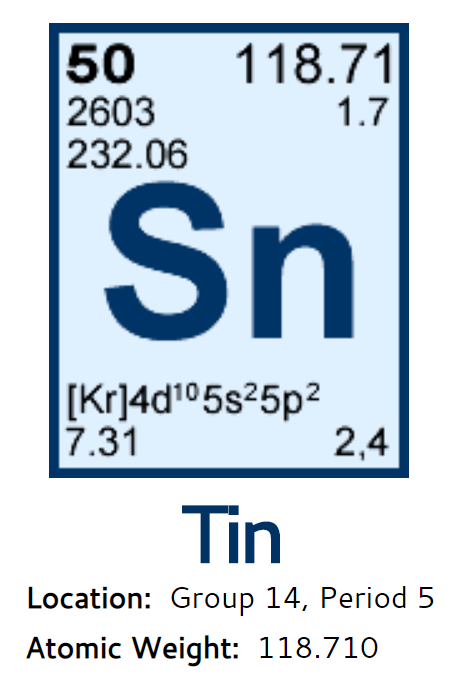
_
For some reason, I got to thinking sn63 had something to do with it being silver bearing. I have used for years and years a silver bearing solder from radio shack. It's the only thing I used to buy there! I have numerous rolls, but someday will need a replacement.
Looking at a newer roll, it says "62/36/2 silver bearing". Maybe I've seen "sn62" on old rolls and assumed it was some designation indicating silver bearing. I learned of it from an old article from Stereophile magazine. "Aunt Corey's Buffered Preamp." Reference to the periodic table didn't even occur to me!
Guess I will eventually gravitate to the WBT stuff, but it is nowhere near as inexpensive as this stuff was. Seems I've got some good old Kester around here somewhere. (non silver bearing)
Russellc
Looking forward to your comparison.Just completed my build tonight, I have teabags boards in right now and building up the m2x for a comparison. Shielding wasn’t needed with the layout.
I used a 4.3k in series with R7 to mitigate the negative offset
This build puts out 22.5wpc at 1%THD
I spent most of the weekend listening to my M2x, what a difference compared to the ACA's. I'm very impressed by how quiet it is, no hum and very little noise at full volume only. Still using Mountain View and will continue for the next couple of weeks.
I found a nice wooden box to hold all the daughter cards, I like amplifiers with accessories.
I found a nice wooden box to hold all the daughter cards, I like amplifiers with accessories.
Attachments
I have a question regarding the Ishikawa boards, I have not bought the JFET's yet. I'm lost trying to figure out how to adjust RV1, if not by listening, then how?
I have three DMM, a Tektronics scope 2225, and function generator.
I've read the M2x and F5t threads and only found one post by 6L6 regarding the adjustment of Rv1. I searched Google on his recommendations for software, however, they require a laptop with a special sound card, which I do not have. What other tool will measure the results of RV1 and what is the adjustment results I would want.
I have an F5t in progress, so I'll have 6 PC boards with this pot to adjust, so I need to get good at adjusting.
I have three DMM, a Tektronics scope 2225, and function generator.
I've read the M2x and F5t threads and only found one post by 6L6 regarding the adjustment of Rv1. I searched Google on his recommendations for software, however, they require a laptop with a special sound card, which I do not have. What other tool will measure the results of RV1 and what is the adjustment results I would want.
I have an F5t in progress, so I'll have 6 PC boards with this pot to adjust, so I need to get good at adjusting.
That's a great box for the IPS boards!
The M2x is definitely a step up from the ACAs, even the ones that I've done a lot of extra work on. I've added some additional capacitance to the linear power supply of my ACA-220 v2, and it is now as quiet as my M2x. I still hear a wider soundstage with my monoblock and dual-mono ACAs than with my M2x, but that's dependent on which IPS I have in the M2x.
So far my Mtn View with the 2.048V precision reference IC has the blend of detail, dynamics and imaging that I prefer for most of my listening. The Ishikawa is a very close second, and only because it lacks the imaging detail that I get with the Mtn View. The Ishikawa has a wonderfully clean and dynamic tonal presentation, similar to the SMD Tuscon, but not quite so analytical. Today I will be testing some thoughts with a new pair of modified Ishikawa IPS veroboard prototypes that I built.
The M2x is definitely a step up from the ACAs, even the ones that I've done a lot of extra work on. I've added some additional capacitance to the linear power supply of my ACA-220 v2, and it is now as quiet as my M2x. I still hear a wider soundstage with my monoblock and dual-mono ACAs than with my M2x, but that's dependent on which IPS I have in the M2x.
So far my Mtn View with the 2.048V precision reference IC has the blend of detail, dynamics and imaging that I prefer for most of my listening. The Ishikawa is a very close second, and only because it lacks the imaging detail that I get with the Mtn View. The Ishikawa has a wonderfully clean and dynamic tonal presentation, similar to the SMD Tuscon, but not quite so analytical. Today I will be testing some thoughts with a new pair of modified Ishikawa IPS veroboard prototypes that I built.
I'm lost trying to figure out how to adjust RV1, if not by listening, then how?
Distortion analyzer and oscilloscope, or soundcard/audio software.
Or set in in the middle and don't worry about it...

I have a question regarding the Ishikawa boards, I have not bought the JFET's yet. I'm lost trying to figure out how to adjust RV1, if not by listening, then how?
I have three DMM, a Tektronics scope 2225, and function generator.
I've read the M2x and F5t threads and only found one post by 6L6 regarding the adjustment of Rv1. I searched Google on his recommendations for software, however, they require a laptop with a special sound card, which I do not have. What other tool will measure the results of RV1 and what is the adjustment results I would want.
I have an F5t in progress, so I'll have 6 PC boards with this pot to adjust, so I need to get good at adjusting.
P3 Adjustment for the average Hobbyist
Russellc
Thank you Russellc and 6L6, I need to spend some time watching you tube videos!
There are a few tidbits in the BA3 as preamp threads and Zenmods M25 thread.
You need laptop, ARTA (free) and a Focusrite 212 thingie.
Russellc
An old HP 339A distortion analyzer will not only give you a numerical indication of THD (relative to a 1.0 kHz test tone), but also provides an output of the residual harmonics, which may be viewed on a separate scope. This lets one know whether the harmonics are primarily second or third order (2x or 3x the test tone). Unless you have a really good digital scope ($$$) or soundcard with FFT software ($$$), I think the easier way is to look at good old analog waveforms to judge harmonic content. The typical ADC and digital signal paths in less expensive digital hardware don't have the resolution to do proper analysis as well as 'antiquated' analog gear.
- Home
- Amplifiers
- Pass Labs
- The diyAudio First Watt M2x
